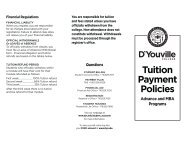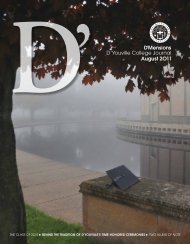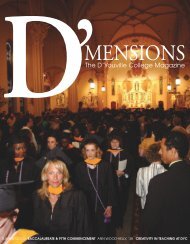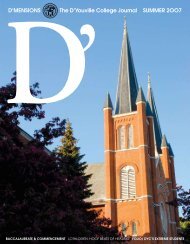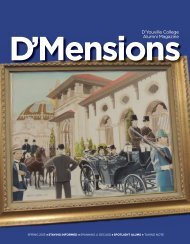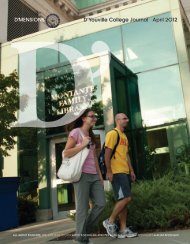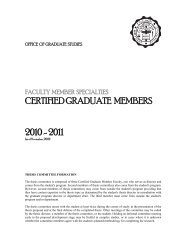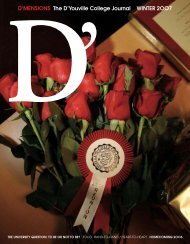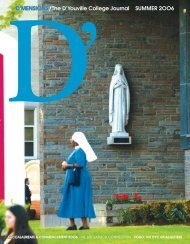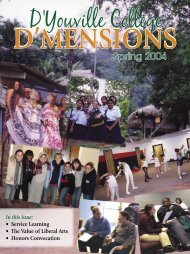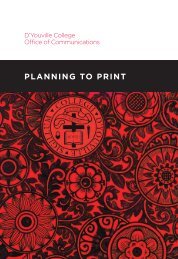D'Mensions Spring 2005.indd - D'Youville College
D'Mensions Spring 2005.indd - D'Youville College
D'Mensions Spring 2005.indd - D'Youville College
You also want an ePaper? Increase the reach of your titles
YUMPU automatically turns print PDFs into web optimized ePapers that Google loves.
tEducation always preceded action in the D’Youville scheme.he trek from the Red River area nearOttawa, Canada, was made in 1857 by train and by riverboat to Lewiston, New York, and thento Buffalo by open wagon. Sister St. Julienne and several Grey Nuns of the Cross came here at theinvitation of Bishop John Timon to care for the poor and the indigent sick and to teach the children ofHoly Angels Parish. A swift half-century later, in 1908, under the dynamic and visionary leadershipof Sister Stanislaus Burns and the Grey Nuns, Holy Angels Academy had evolved into D’Youville<strong>College</strong>, which formally opened its doors with nine students enrolled. Thus, the first internationalbonds were forged between French Canadians and the Americans of D’Youville <strong>College</strong>.During World War I, Europe became a killing field. In 1918, three young women from France soughtrefuge here as the college’s first foreign-born students. Following the Treaty of Versailles, D’Youvillewas foremost among women’s colleges in a nationwide effort to extend aid and “the hospitality of itshalls” to both French and Belgian women unable to continue higher education in their homelandsbecause of the extensive reconstruction needed in their war-torn countries.Simultaneously, Mary Chabot, ’18, one of the first among 100 social service workers selected bythe Catholic War Council, went to France to establish institutes and to teach English. A two-wayinternational exchange became operational.A year later, Mlle. de Saint Exupery, lady in waiting to the sister of King Albert of Belgium, also cameto D’Youville to investigate Catholic education methods, the housing of workers, nursing among thepoor, etc., searching for new techniques in facilitating Belgian reconstruction. A flow of informationnow crisscrossed the Atlantic.During the post-war years up to 1929, Buffalo became the premier city in the world in flour millingand feed production, the second largest railroad center in America, and a leading producer of ironand steel, autos and airplanes, of textiles, cement and chemical products. To support Buffalo’s worldscaleindustry great numbers of foreign-born workers settled in this area: hundreds of thousands ofIrish, Poles, Germans, and Italians who became the very bone and sinew of industrial Buffalo. Mostof them, however, did not speak each other’s language. Buffalo soon became the epicenter of ethnictensions as it reeled under the blows of the Great Depression throughout the early- and mid-thirties:For the unskilled worker, public relief became a way of life.In 1938, under the innovative leadership of Father William J. Kelley, O.M.I., the concept of thecredit union and its practical values were introduced: how a bank is formed, how it operates, and howto realize the benefits to be accrued from it. He assembled 44 business executives who headed Buffalo’smajor companies, as well as school principals, railroad officials and prominent attorneys—all of whomendorsed the proposal.The credit union as a socio-economic remedy for working out the complexities and tensions of alarge city was conceived as a model for other cities, as well as for Buffalo. The credit unions wereto exist for lending money to members in time of need. Members bought shares at a nominal cost,made loans, and repaid monies in modest installments, with interest revenues redistributed to its ownmembers based on share ownership.D’Youville assumed leadership, making one of the college’s most outstanding contributions to theeducation of the people of Buffalo when its administration sponsored the Co-operative Institute, thefirst free school on credit unions in New York state. The college offered free courses in cooperativebanking three evenings a week. Area radio broadcasts complemented the lectures.In under two years, over 10,000 people organized into credit unions with federal charters: locals ofvirtually every major skilled labor, by industry or by plants, by groups such as libraries, hospitals andschools. Eventually, the Institute embraced 50,000 members, including individual Catholic parishes,maternity guilds that secured low-cost health care, and student cooperatives. Ultimately, it established60 actively functioning credit union banks.International FOLIOTHE ROOTSOF OURINTERNATIONALISM1918Three young women fromwar-torn France arriveat DYC to pursue collegestudies.1950’s<strong>College</strong> records list studentsfrom Japan, Ukraine,Puerto Rico, DominicanRepublic, El Salvador,Poland, Korea, Taiwanand Guatemala.1959Fleeing Communistoppression,the Hungarian Sistersof Social Servicecame to D’Youvillefor their education.1963International Alumni Day:Groups gatheredthroughoutthe United Statesand met to celebratein other lands such asLuxembourg,Virgin Islands, Italy,Ethiopia, Hong Kongand England,as well as in Canada.Today:Students and alumni areworldwide, includingNigeria, Belarus, Boliviaand Vietnam.11



